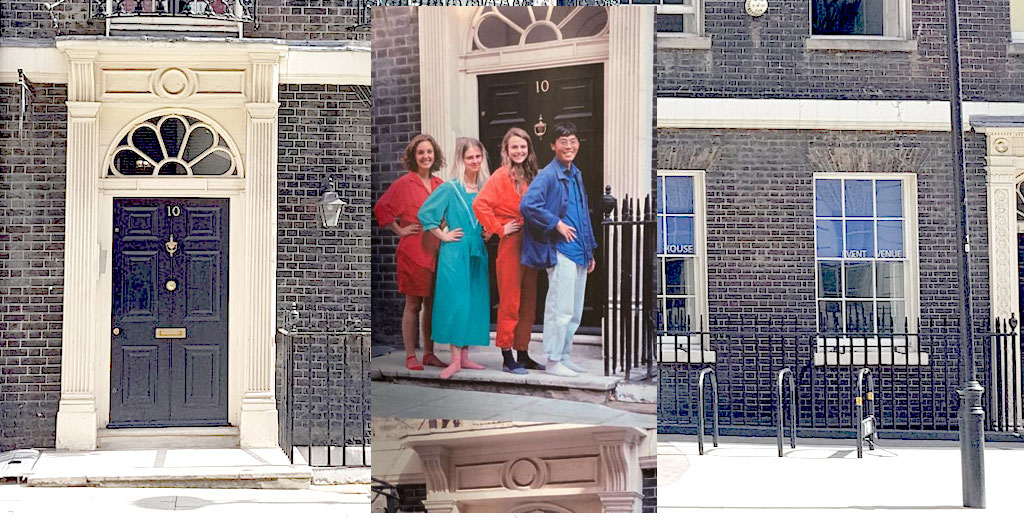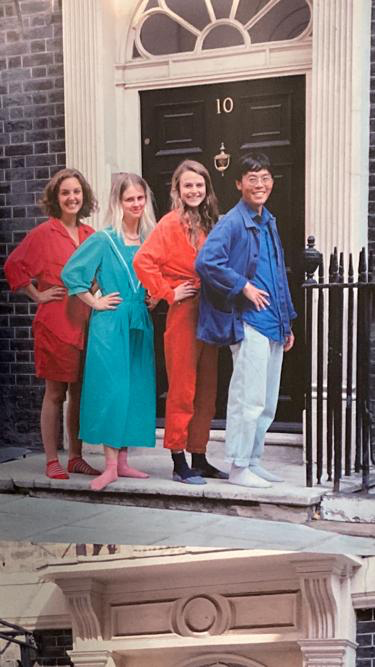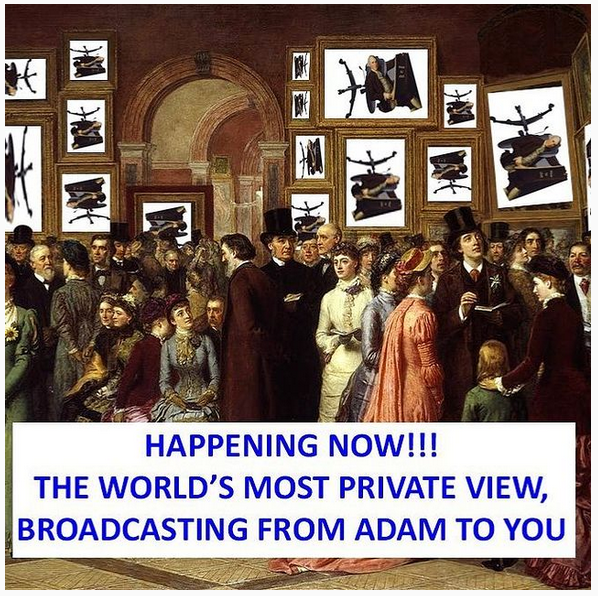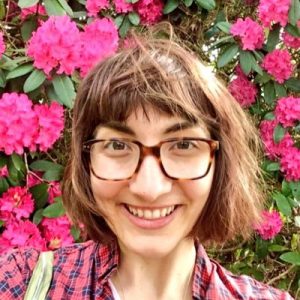ADAM: “four artists in an office off the Strand”
Posted in Strandlines and tagged with

10 Adam Street has a famous-looking front door. You can pose in front of its glossy black paint, brass metalwork, and stone steps, pretending to pay a visit to that other Number 10. However, I would suppose, the mood inside both buildings couldn’t be more different.
Helen greets me when I arrive, with shoes off and facemask on: the first indication that ADAM is both homely and a workspace. “ADAM is the name of the project, not a person”, she explains. As a Strand nerd, I had guessed as much. But other visitors have asked, not aware of the history of the area. In short, ADAM is christened after Adam Street, which is named after John, Robert, James, and William Adam. In the eighteenth century, the brothers cleared marshland along the Thames’ Strand bank and sunk their money (bolstered by fundraisers) into the neoclassical Adelphi buildings. Although much of the Adam-built estate was demolished in the 1930s, the new art deco block and street names remember the brothers and their ambitious project.
Helen Wilson, Alastair Kwan, Millie Laing Tate, and Hannah Dinsdale are four of the newest residents. They are all in the second year of their two-year MA in Sculpture at the RCA, and each have their own practice, other jobs or teaching work. Together, they can be found at both 10 Adam Street and their virtual home @adamthestrand on Instagram.
Helen explains that over the summer, the RCA informed cohorts that they’d only have studio space for 2 weeks at a time on rotation, due to the need for extra space per person with COVID safety rules. This was a huge blow for most students, who are used to keeping materials on site, with easy access to various specialist materials and tools.
Hannah started looking for alternative studio spaces to rent as soon as she heard the news. “We looked at a ‘WeWork’, and even spare rooms and basements in private homes in north London”, but the WeWork felt too corporate and exposing with its glass booths, and none of the spare rooms were promising. Luckily, 10 Adam Street came up on their search, and the building manager Stefan agreed to an affordable rate for the group.
Millie explains that they moved into a 2nd basement space in the first week of September, and the initial plan was to use the space just through that month. In October, their current space on the Lower Ground floor became free, with a bigger window and room enough for a long desk, computer and 3D printer, and enormous beanbags made by Hannah. The kitchen just across the hall is communal, but hardly anyone else is in the building now, so they also have also coopted that space. “Before the summer, the building was apparently always full. Now it’s just us, a hypnotherapist upstairs, someone storing furniture, a couple other offices… but we don’t see many people around at all.”
Hannah explains that when cycling to and from ADAM she mainly passes construction workers. On the roads around Covent Garden especially, office furniture removal vans seem to be doing good business. Alastair adds that in early September the Strand area still felt quiet, but over October, even though the weather was so bad, with the temporary lockdown easing the Strand was busier with tourists, shoppers, and people dressed in office wear. Millie paid a visit to Smith and Wollensky in October, thinking to take advantage of the luxurious bar while it was quiet. It turned out to be “so busy”, “people seem to just want things to be normal”. For Millie, the Strand is much busier than her neighbourhood in Notting Hill, where “many shopfronts are just empty now”. However, Helen commutes to ADAM from Finsbury Park, and she finds central London comparatively quieter: “everyone in north London seems to be working from home and walking around the park on their breaks, which is busier than ever.”
ADAM has presented many opportunities for creative working and thinking, with the group mining the local area and history for ideas, and exploring collaborative working and Open Calls. Hannah explains that “other studios are so sterile, and abstract, whereas here we are surrounded by buildings and different spaces”.
Helen recounts a zoom lecture kindly given to them by architectural historian Colin Thom, a researcher at the Bartlett, about the history of the area. Many of the architectural and interior decorating decisions made by the Adam brothers were inspired by the ‘Grand Tour’ of Europe. The Grand Tour was an excursion to give first-hand encounters with Classical architecture and art, as a sort of finishing school for young wealthy architects, artists, and gentlemen. (If you’d like to learn more, Thom is currently in the midst of a research project to produce a critical edition of Robert and James’ Grand Tour correspondence.)
Helen explains that “recently, lots of decisions we’ve made, we ask each other ‘what did Colin Thom say?’”. They went to look around the Royal Society of Arts just around the corner, and marvelled at the ornate interiors, and displays of ostentatious wealth. The ceiling designs inspired print patterns, while the neoclassica from the building’s interior and exterior sparked an idea to turn themselves into gold statues, which they explored using 3D printing methods. Earlier on the day I visited, they had been posing on an office chair in the kitchen and scanning themselves.
Alastair is running the 3D printer as we chat, and toward the end of the interview he hands me a freshly printed version of Hannah. One idea being explored is to create ‘souvenir boxes’ that they can sell, to help fund their ADAM rent. The group didn’t feel comfortable asking for donations, so they are investigating ways of setting up an online gallery-shop for their work, linked to their Instagram account. Hannah explains how the group want to make the most of a growing interest in affordable art, and people enjoying getting parcels and post during lockdown, so they are thinking about pieces they can offer as editions.
This souvenir project and 3D printing experiments speak of a key change in practice that ADAM has enabled: while the artists had shared studios before, they had never collaborated. Alastair describes that he has been working much smaller than usual. He usually makes videos, but recently has become more interested in technologies like 3D printing, and using cheaply-available apps. Helen explains that she has found she’s working with the same materials as she usually would, but embracing a new “democratic process” as they plan what to work on together. Millie explains that everyone has had to adapt — she has been using more performance — but a benefit of their group dynamic is that they make sure everyone has time to focus on their individual practice too.
Hannah laughs and says she is still “bad at going off on one” and following threads of ideas before bringing everyone along. Hannah found she went into experimental mode during lockdown, making lots of work. She reflects that she was “worried about losing momentum, and I just felt depressed without doing things, and at the thought of losing the studio [at college]”. She explains that in her RCA studio space and at home she likes to surround herself “with a lot of stuff”, but she can’t bring everything with her to ADAM, so her usual frantic pace has been slowed down. She’s been focussing on “making work to shift the mood of a room”, which includes the huge beanbags, one of which I am perched on, and trying not to curl up into as I make notes (it’s so cosy!).
Another key difference for everyone has been social media use. None of the group were big on Instagram before the project. Hannah explains, “I’ve never had to work out how to get followers before, but now I’ve been looking up hashtags and Instagram tips”. A key aim of the project is to share and build community, giving themselves a platform as much as opening up space for collaborators and peers, and Instagram has been an important tool for this.
ADAM held an Open Office back in September. Hannah explains, “we weren’t sure who would come… people from Instagram just rocked up”. Alastair adds that it was important to hold the Open Offices, as “everyone is missing a sense of community”, and RCA first-years came for a private view. The Open Office days ended up being a series of intimate visits, due to restrictions on numbers of people gathering at one time. Because ADAM is a workspace and educational space, COVID-compliant small group or individual visits can be arranged. “Just DM us and we can work out a visit”, offers Millie (depending on the Tier guidance, of course).
Through their Instagram account, ADAM have also run an Open Call series “Mantle, Monitor, Ledge”, showcasing the work of X artists over three weeks in November and December. The series name comes from the spaces available in the studio, the fireplace mantle, window ledge that can be seen either from inside or by peering down from the pavement above, and the computer screen on the desk. The project had so much interest an additional ‘text’ piece was installed and shared with each iteration, and the team were excited that they had so many applications from people they didn’t know: social media has really helped spread the word. Show 001 featured work by @mariannelwalker, @a_aaartist, @samcarvosso, and @harry.gammer_flitcroft; 002 included @tabsclouds, @tobyupsonofficial, @healing.grotto and @araceli.gomezcastro; 003 featured @______prawn, @konrad_jakubowsky, @tom_railton and @kimmi_mcintosh. Find work from each series on the ADAM Instagram posts and stories, as well as their website, and look out for new open calls!
All the Mantle, Monitor, Ledge shows were organised so they could happen during and despite changing lockdown restrictions. When small group visits were allowed, members of ADAM took it in turns to be on site to let people in, but during the stricter lockdowns the shows moved totally online, with participating artists taking over the @adamthestrand Instagram feed and stories, and eventually the website. An Instagram post advertising Mantle, Monitor, Ledge 001 promised the “world’s most private view”, an optimistic way to think around COVID with online streaming!
When ADAM moved in at the start of September, they only planned to rent for a month or so. They then extended to the end of the calendar year. Now it’s January, and the group want to stay at ADAM as long as they can.
Millie explains that setting up the space has been a “saving grace”, as it’s “so disorienting” with ever-changing COVID rules disrupting usual ways of working for almost a year now. Alastair agrees, “others at the RCA don’t have this and may have found the term harder”. Hannah adds that “our experience is constantly shifting as every time we meet and discuss our manifesto, ideas and intentions, it seems to change from one week to the next – as Covid restrictions change, the strand changes as well as access to physical and virtual space – meaning artwork is constantly developing, being limited or expanded in different ways”. Between making their own work, collaborative work, running an Open Office in the autumn, and organising the “Mantle, Monitor, Ledge” open call, Helen adds that “this is the busiest I’ve felt ever”, and Millie adds “it feels odd to be busy when we know other people aren’t, and have had to stop working, or they can’t work for whatever reason”.
Although I hate the word (you would too if you’d attended workshops on the topic delivered by people who wear suits in their own homes), I love the resilience that ADAM represents. We can’t let creativity disappear, even with, and especially because of, extraordinarily hard times. If only all empty buildings, vacated as white-collar workers set up home offices, had to be given over to artists and community focussed groups. Even better if big businesses kept paying the rent. I certainly hope that estates companies will consider truly affordable opportunities during and after the pandemic. With the arts suffering from chronic under-funding at the best of times, it’s more important than ever to support and celebrate creative communities.
See previous work, work in progress, ‘Mantle, Monitor, Ledge’ archives, and more on @adamthestrand on Instagram, and on their website http://www.adamthestrand.com.



